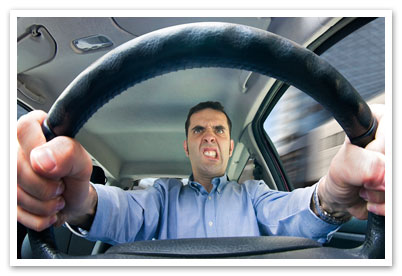The first Friday in October is National Body Language Day. Our body language shows those around us how we’re feeling without us saying it. Body language can reveal positive emotions, but it can be used to express negative emotions just as easily. What does this have to do with driving? Keep reading to find out!

Negative Body Language
Emotions can run high when we’re driving. It may not seem like a big deal to get behind the wheel when you’re extremely excited or upset (it may even seem unavoidable), but it can be dangerous. Research shows that when a driver is highly emotional, they are more distracted and less attentive to the road than a driver who is using a cell phone.
Drivers who are affected by their high emotions exhibit the following:
- Slower reaction times
- Impaired observations
- An inability to predict or determine what other roadway users are doing
Even though other drivers can’t hear us when behind the wheel, they can still read our body language. If someone cuts you off and you make a rude gesture at them out of anger, you’re putting yourself at risk of retaliation. You never know what’s going on in another driver’s head. If someone with an anger problem sees you making a disgruntled face or shaking your head at them, it could be the thing that sets them off that day, resulting in road rage.
If you come in contact with a driver who is displaying aggressive body language and/or aggressive driving behaviors, you should:
- Not retaliate or in any way engage the other driver
- Not make eye contact
- Keep your vehicle doors locked and the windows up
- Keep enough space between your vehicle and the aggressive driver in front to pull out from behind
- Not underestimate a driver’s potential for aggression
Following these simple rules while driving will help prevent any unnecessary collisions from happening because of aggressive driving. Try to keep your body language neutral in these instances so as to not escalate the situation.
Positive Body Language
On the other hand, body language can be a useful and needed tool when sharing the road with others, especially pedestrians. Before crossing the street, a pedestrian may look you in the eye to make sure you are paying attention. They don’t want to get run over by a distracted driver! When a pedestrian makes eye contact with you and clearly wants to cross in front of you, smile and wave to indicate that it is safe for them to cross.
Pedestrians may wave at you if they are trying to get your attention. To indicate that you have seen them, you can nod your head and/or move over to give them room. You should never honk to get the attention of pedestrians or bicyclists unless they are in immediate danger.
Body language can also be useful in right-of-way situations. It can be confusing at times to navigate the rules of right-of-way at intersections. Here’s something to keep in mind moving forward: right-of-way isn’t something you automatically have. Instead, it’s something that you give to someone, or that someone gives to you.
Your body language is important when it’s tme to give or accept the right-of-way. If it’s unclear whose turn it is to go, try to make eye contact with the other driver. Smiling and waving them ahead will reassure them that they’re safe to cross and they’re not in any danger. When someone gives you the right-of-way, you can acknowledge them by giving a little wave to say thank you.
Positive body language while driving helps everyone feel more comfortable and communicates your intentions to those around you.
Always make sure you’re driving defensively, not aggressively!
Interested in traffic safety? Taking an online defensive driving course or an insurance discount course is a great way to help prepare you for any type of driving situation! Click here to visit our website to see the online courses we offer in your state!
The first Friday in October is National Body Language Day. Our body language shows those around us how we’re feeling without us saying it. Body language can reveal positive emotions, but it can be used to express negative emotions just as easily. What does this have to do with driving? Keep reading to find out!